Chapter 15 - Transcription & Translation
1/16
Earn XP
Description and Tags
Used the ch. 15 wrap-up and slides
Name | Mastery | Learn | Test | Matching | Spaced |
|---|
No study sessions yet.
17 Terms
Order of events for the central dogma
DNA → RNA → Protein
Replication on DNA inside the nucleus
DNA is transcribed into RNA inside the nucleus
RNA is translated into proteins in the cytoplasm
Protein synthesis occurs in ribosomes in the cytoplasm
Beadle and Tatum’s experiment
One enzyme, one gene hypothesis - surmised that each gene would influence a specific step in a metabolic pathway
Knowledge formed based on their findings:
Genes encode for proteins other than enzymes
Genes may encode a subunit
Some genes encode for non-coding RNA’s
Many genes have more than one exon & can be processed differently to develop different proteins
Define the term gene
specific sequence of nucleotides on a strand of DNA
aid i the development of specific traits
usually result in a protein product
before protein synthesis… an RNA copy called “transcript,” of the gene must be made (mRNA)
Reading Genetic Code
A gene is interpreted by reading the codons but… these codons must be read in the correct reading frame
Which nucleotide starts the first codon of the coding region of the gene
Always starts with the “start codon” AUG which encodes the amino acid Methionine
Prokaryotic gene expression
Happens solely in the cytoplasm
Do not require RNA transcript modification- their RNA transcripts can be translated immediately after being transcribed
RNA transcript can be transcribed and translated at the same time
multiple polymerases can transcribe a single gene
numerous ribosomes can concurrently translate the mRNA transcripts into polypeptides (polyribosomes)
This can allow a specific transcript and/or specific protein to rapidly reach high concentration in a cell
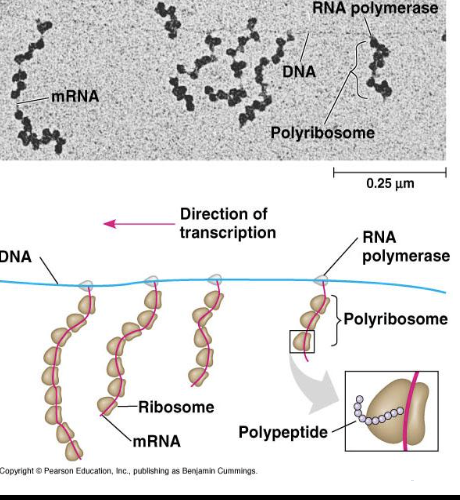
Eukaryotic gene expression
transcription and mRNA modification occur in the nucleus
translation occurs in the cytoplasm
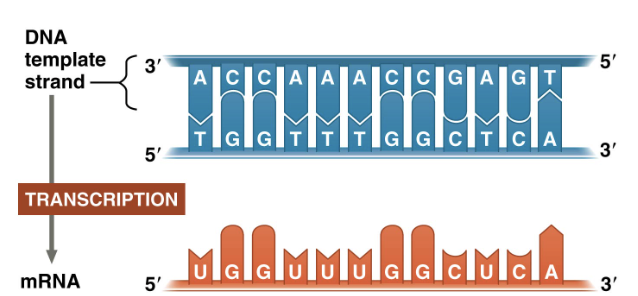
Overall process of transcription
The gene sequence determines the sequence of bases along the length of a mRNA molecule. RNA is compromised of A, U, C, G
Occurs in the nucleus of eukaryotic cells
RNA polymerase is THE enzyme (she is THAT girl)
What do promoter sequences do in the initiation phase of transcription?
A sequence of DNA that serves as recognition and recruitment site for transcription factors and RNA polymerase
What do transcription factors do in the initiation phase of transcription?
Proteins that aid in the initiation and regulation of transcription
What do RNA Polymerases do in the initiation phase of transcription?
Synthesize the RNA transcript
Breaks hydrogen bonds between DNA strands and links together RNA nucleotides (same base pairing rules except RNA uses uracil instead of thymine)
RNA polymerase can only add nucleotides onto the 3’ end of the growing RNA transcript
Several types (I, II, III)
What are the steps for initiation in transcription
Transcription factors bind to promoter region of the gene needing transcription
T-factors recruit RNA polymerase to bind and form an initiation complex
RNAP will then recognize this start sequence and begin to synthesize the RNA transcript in a 5’ to 3’ direction
Reads 3’ to 5’
Writes 5’ to 3’
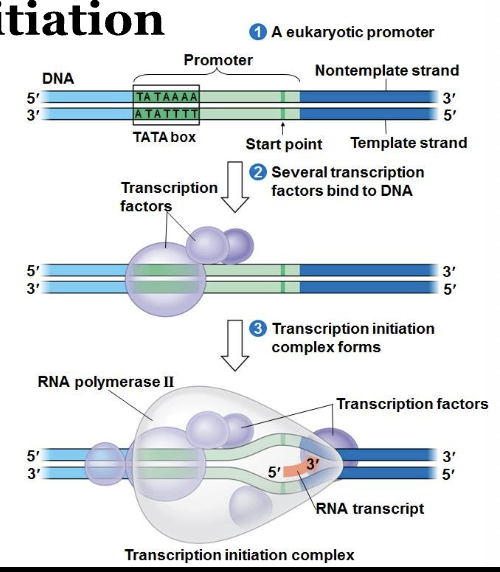
What is the importance of the elongation phase in transcription
It is where the production of the RNA transcript occurs

What is the role of RNAP in the elongation phase in transcription
Unwinds DNA to access the template strand (only exposes around 10-20 nucleotides at a time)
Connects the RNA nucleotides using DNA as a template
produces RNA transcript in a 5’ to 3’ direction
Temporary attachment
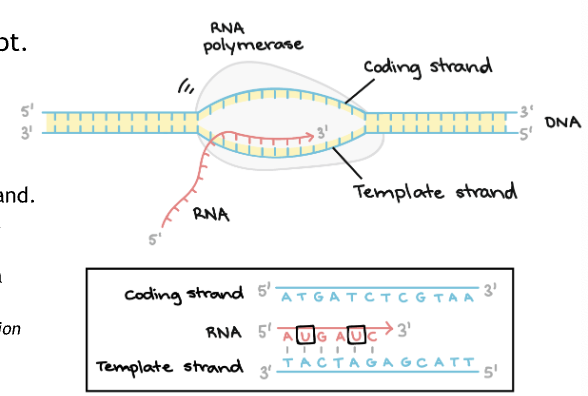
What are the steps for the elongation phase of transcription
RNAP unwinds DNA
RNAP reads 3’ to 5’ direction the the DNA nucleotides from the template strand and attaches RNA nucleotides
RNA nucleotides are joined to the previous one on the 3’ end by a phosphodiester bond along its backbone
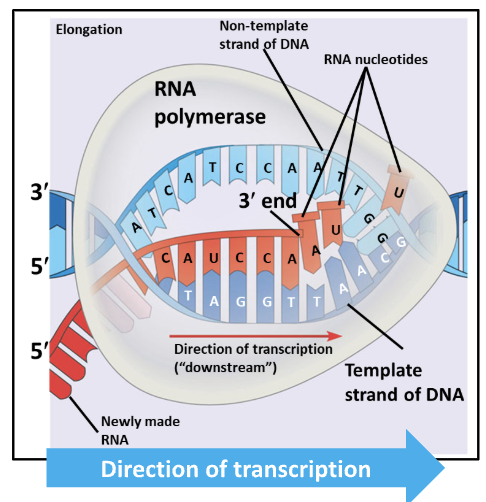
What is the role of terminator sequences in the termination phase of transcription
sequences of DNA at the end of a gene that is transcribed and signals the RNA transcript is complete
What are the steps for termination in transcription
RNAP reaches and transcribes the termination sequence
RNA transcript is released by RNAP
RNAP detaches from the DNA, ending transcription
GOAL of termination phase is to completely disassociate RNAP from DNA by stopping transcription and releasing the new RNA strand
How does the termination phase of transcription vary for prokaryotes versus eukaryotes
Pro-
Euk-